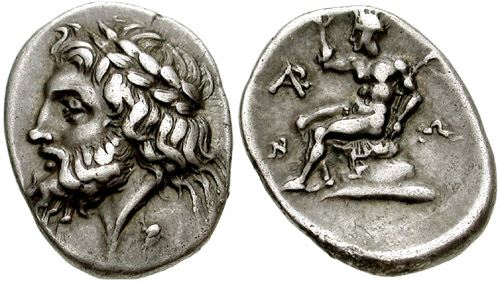Megalopolis, silver, triobols (195-182 BCE)
From SILVER
195 BCE - 182 BCE Silver 2,201 kg
Description
| ObverseInscription or printing placed on the obverse.: | Laureate head of Zeus left, pellet below |
| ReverseInscription or printing placed on the reverse.: | Pan seated left on rock holding lagobolon in left arm, ARK monogram before, N before, W behind. |
Mint and issuing power
| MintIdentifies the place of manufacture or issue of a numismatic object.: | Megalopolis | Ancient regionAncient region.: | Peloponnesus | Modern countryModern country: Greece | AuthorityIdentifies the issuing power. The authority can be "pretended" when the name or the portrait of X is on the coin but he/she was not the issuing power. It can also be "uncertain" when there is no mention of X on the coin but he/she was the issuing power according to the historical sources: |
Chronology
| FromIdentifies the initial date in a range assigned in a numismatic context. | 195 BCE | toIdentifies the final date in a range assigned in a numismatic context.. | 182 BCE | PeriodTime period of the numismatic object.: Hellenistic 323-30 BC |
Physical description
| MetalThe physical material (usually metal) from which an object is made.: | Silver |
Median weightMedian of the weights of numismatic objects (in grams). in grams | 2.70 | DenominationTerm indicating the value of a numismatic object. Examples: tetradrachm, chalkous, denarius.: | triobol |
StandardStandard.: |
Image

H175 Megalopolis.jpeg [1]
References
| Die study referencePublication of the study: | Dengate 19671Dengate 1967, p. 57-110, pl. 20-28. | ||
| Coin series referenceReference to coin series study: | Sear I2Sear I, n° 2719, RQEMH3RQEMH, n° 175, HGC 54HGC 5, n° 948 | ||
| Coin series web referenceCoin series web references: | |||
Obverse dies distribution
| FrequencyFrequency of specimen in distribution. ᵖ | Number of obversesNumber of obverse dies. ᵖ (o) | % (o) | Number of coinsNumber of coins. (n) | % (n) | Die nameName(s) of the die(s). |
| 1 | 12 | 35.29 | 12 | 9.84 | 4, 7, 9, 13, 14, 16, 19, 20, 25, 27, A1, A7 |
| 2 | 5 | 14.71 | 10 | 8.2 | 11, 15, 22, 23, A6 |
| 3 | 5 | 14.71 | 15 | 12.3 | 1, 3, 18, 26, A3 |
| 4 | 1 | 2.94 | 4 | 3.28 | A4 |
| 5 | 2 | 5.88 | 10 | 8.2 | 2, 6 |
| 6 | 3 | 8.82 | 18 | 14.75 | 12, 24, A5 |
| 8 | 4 | 11.76 | 32 | 26.23 | 5, 17, 21, A2 |
| 10 | 1 | 2.94 | 10 | 8.2 | 10 |
| 11 | 1 | 2.94 | 11 | 9.02 | 8 |
| Total | 34 of 34 | 99.99 | 122 of 122 | 100.02 |
Reverse dies distribution
no distribution is available
Quantification
| Number of obversesNumber of obverse dies. ᵖ (o) | 34 | Number of singletons (o1)The number of singleton coins. ᵖ | 12 |
| Number of reverse diesNumber of reverse dies. (r) | 57 | Number of coinsNumber of coins. (n) | 122 |
| Coins per obverse dieNumber of coins per obverse die. (n/o) | 3.59 | Coins per reverse dieNumber of coins per reverse die. (n/r) | 2.14 |
| Reverse per obverse ratioRatio of obverse dies divided by reverse dies. (r/o) | 1.68 | Percentage of singletons (o1)number of coins (n) divided by the number of singletons (o1) ᵖ | 35.29 % |
| Original number of dies (O) (Carter 1983 formula)The estimation of the number of coins according to Carter 1983 ᵖ | 40.76 | Coins struck if 20,000 as average productivity per dieCoins made if the average productivity for obverses (according to Carter) is 20,000. ᵖ | 815,200 |
| Original number of dies (O) (Esty 2011 formula)The estimation of the number of coins according to the singleton formula in Esty 2011 ᵖ (O) | 47.14 | Survival rate if 20,000 as average productivity per dieSurvival rate if average productivity is 20,000. ᵖ | 0.00015 |
| Coverage (o = % of O) (Esty 1984 formula)Esty 1984 - coverage (% of O) ᵖ (o = % of O) | 90.16% | Die productivity if survival rate 1/2,000Average productivity if survival rate is 1/2,000. ᵖ | 5,986.26 |
| Weight of silver (in kg) if 20,000 coins per die (O = Carter formula)Carter 1983 * Median weight * 20000 (*10 if gold or electrum) ᵖ | 2,201 kg <br /> 2,201 kg | Die productivity if survival rate 1/5,000Average productivity if survival rate is 1/5,000. ᵖ | 14,965.65 |
Remarks
Most likely one single workstation Likely military
References
- ^ Dengate J. A. (1967), "The Triobols of Megalopolis", American Numismatic Society Museum Notes 13, p. 57-110, pl. 20-28.
- ^ Sear, David R. (1978), Greek coins and their values. Vol. I, Europe, London, xl, 316 p.
- ^ Callataÿ, François de (1997), Recueil quantitatif des émissions monétaires hellénistiques, Numismatique Romaine, Wetteren, X + 341 p.
- ^ Hoover, Oliver D. (2011), Handbook of Greek Coins 5. Coins of the Peloponnesos, Achaia, Phleiasia, Sikyonia, Elis, Triphylia, Messenia, Lakonia, Argolis, and Arkadia, Sixth to First Centuries BC, Lancaster (PA), 2011.